SWISS HISTORIC HOTELS FRANÇAIS



Tous les livrets en un coup d’œil. All booklets at a glance. MySwitzerland.com/brochures

Celui qui cherche l’insolite trouve son bonheur dans ce livret, car c’est le temps qui a modelé les Swiss Historic Hotels. Chacun d’entre eux envoûte par le charme et la puissance qu’il dégage, alliant avec aise l’ancien et le nouveau. Nous vous souhaitons de belles découvertes à travers le temps. Et il y a bien plus à découvrir!
Envie de s’immerger par exemple dans la tradition suisse et de se mettre en plus aux fourneaux? Le livret des Typically Swiss Hotels est la promesse d’authenticité. Si vous optez pour des vacances en famille et aimez les contes pour enfants, le livret des Family Hotels va vous enthousiasmer. Et si vous cherchez la voie vers un avenir prometteur pour votre entreprise, celui des Inspiring Meeting Hotels apporte une première réponse.
I f you’re looking for something extraordinary, you’ll find your hideaway in this booklet, since the course of time has shaped the Swiss Historic Hotels. Each inspires guests with its own character and impressive appearance, playfully combining old and new. We hope you enjoy travelling through time.
And there is so much more still to be discovered!
If you’re looking to immerse yourself in Swiss tradition and enjoy cooking, we highly recommend the booklet on Typically Swiss Hotels. If you’re travelling with the entire family and like children’s stories, you’ll love this booklet on Family Hotels. And if you want to find the right focus for a successful future for the whole company, you’ll find it in the booklet on Inspiring Meeting Hotels.
Voyage dans le temps. Time travel.

Critères d’hébergement. Accommodation criteria.
1 – 61 Swiss Historic Hotels
Carte. Map.
Légende. Legend.
Partons pour un voyage à travers le temps et les différentes époques de l’histoire du tourisme suisse. Nous faisons une halte auprès des voyageurs qui sillonnaient jadis les grandes routes commerciales – du nord au sud ou d’est en ouest. Puis nous jetons un œil dans les hôtels de la Belle Époque, où se retrouvaient la haute société et l’élite intellectuelle de toute l’Europe. Pour finir, nous suspendons notre périple quelques instants pour effleurer les années 1930. Jadis émergèrent avec le style Neues Bauen des espaces propices aux idées et visions nouvelles, pionnières de la modernité. Témoins d’alors, les Swiss Historic Hotels racontent les époques et perpétuent leur style et leur histoire jusqu’à aujourd’hui.
Join us on a journey through time, as we visit the different eras of Swiss tourism. We will stop off to meet those people who travelled the major trade routes – from north to south and from east to west. We will then pay a visit to the stately hotels of the Belle Époque, where members of high society rubbed shoulders with the intellectuals of Europe. Finally, we will take a close look at the 1930s, which was when the “Neues Bauen” (New Building) movement pioneered modernity, creating spaces for new ideas and visions. As contemporary witnesses Swiss Historic Hotels are testament to the various eras, carrying on their styles and stories into the present.
Àl’époque romaine, les Alpes et le territoire suisse d’aujourd’hui étaient traversés par deux axes de transit majeurs. L’un passait par le Grand-Saint-Bernard entre la vallée d’Aoste, la vallée du Rhône et le lac Léman. L’autre, dans les Grisons actuels, reliait le lac de Côme au lac de Constance via le col du Septimer et Coire. La chute de l’Empire romain au cinquième siècle sonna le glas de bien des commerces, et les voies utilisées jadis se détériorèrent faute d’entretien. Ce n’est qu’au Moyen Âge que de nouvelles routes furent construites dans les régions alpines, notamment pour les campagnes militaires ou encore les pèlerinages – sans oublier celles servant au transport du sel et de minerais dans les régions de tradition minière.
In Roman times there were two important transit routes over the Alps in what is now Swiss territory: one over the Great St. Bernard Pass between the Aosta Valley, the Rhône Valley and Lake Geneva, and the other in modern-day Graubünden across the Septimer Pass from Lake Como via Chur to Lake Constance. With the fall of the Roman Empire in the fifth century, trade came to a standstill for long stretches of the routes, and many roads fell into a bad state of repair. It was not until the Middle Ages that new transit routes were established in the Alpine regions, for example for military campaigns or as pilgrimage routes, but also for the transportation of salt and ore in areas with a mining tradition.


En parallèle, de premiers bâtiments furent érigés sur ces axes afin de stocker les marchandises et héberger les voyageurs. Près des chemins muletiers qui sillonnaient à foison les cols alpins, de nombreux nouveaux villages et places de marché virent le jour. Au XIVe siècle, un axe nord-sud éminent fut créé au cœur de la Confédération, à savoir la route par le col du Saint-Gothard. En Valais, le col du Grand-Saint-Bernard était l’un des principaux passages à travers les Alpes. Quant aux cols du San Bernardino et du Splügen dans les Grisons, ils étaient très fréquentés pour le transport des marchandises d’Italie vers la Suisse, et inversement.
HÔTEL WEISS KREUZ À Splügen, la bourgade suisse au départ de la montée vers le col, une auberge fut construite dès le XIVe siècle et resta longtemps une adresse prisée sur le sentier muletier très fréquenté.
The first buildings for storing goods and accommodating travellers were built along major routes. At that time, mule tracks were spread over numerous pass crossings over the European Alps, where various new settlements and market places emerged. In the 14th century, an important connection between north and south was created in the Swiss Confederation with the opening of the route over the Gotthard Pass. In Valais, the Great St. Bernard Pass was one of the most important Alpine crossings. The San Bernardino Pass and Splügen Pass in Graubünden were also heavily used for the movement of goods from Italy to Switzerland and vice versa.
HOTEL WEISS KREUZ There was already an inn in Splügen, the settlement at the mouth of the pass crossing on the Swiss side, as far back as the 14th century. For a long time it was a popular place along the busy mule track.
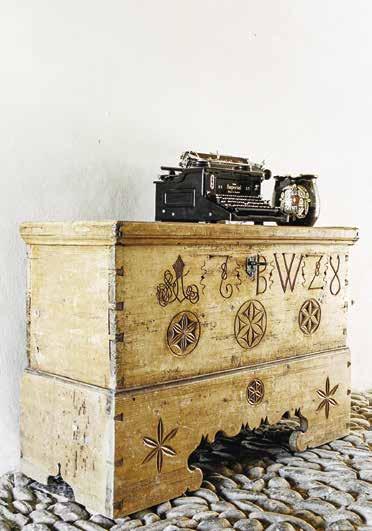
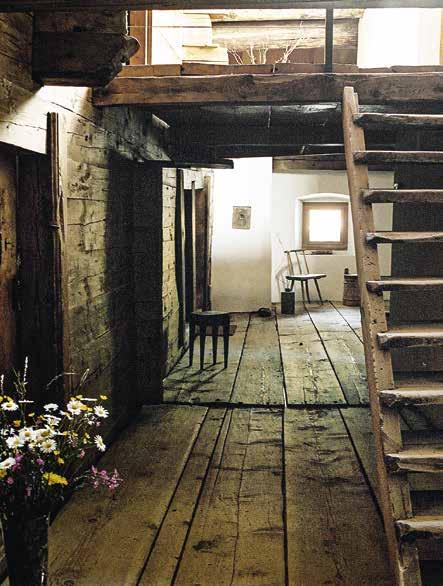
Après 1800, avec la construction au col d’une route pour les calèches par le nouveau canton des Grisons, l’auberge perdit de son importance car le chemin praticable ne passait plus par le centre du village. La bâtisse fut alors utilisée comme ferme des décennies durant. À la fin des années 1990, le service cantonal de conservation des monuments des Grisons, la fondation Pro Splügen et Patrimoine suisse soutinrent sa rénovation et sa transformation en hôtel. Des chambres d’hôtes avec salle d’eau moderne furent installées dans les murs de l’ancienne auberge et la grande salle à manger au mobilier contemporain trouva sa place dans l’ancienne grange à foin au-dessus de l’étable. Depuis, c’est par la grande ouverture en façade, l’entrée historique de la ferme, que l’on pénètre dans l’hôtel. Avec cette transformation architecturale contemporaine, l’hôtel Weiss Kreuz incarne aujourd’hui le jeu subtil du neuf et de l’ancien.
After 1800, following the construction of the coach road over the Splügen Pass through the newly created canton of Graubünden, the inn lost its importance because the navigable route now led right past the centre of the village. As a result, the old building was used as a farmhouse for several decades. In the late 1990s, the building was renovated and transformed into a hotel with the support of Graubünden’s historical monuments conservancy, the “Pro Splügen” Foundation and the Swiss Heritage Society. Guest rooms with modern wet rooms were created within the original spaces of the old inn. The large dining room with modern furniture was situated in the former hay loft above the stable. Since then, the large opening in the façade – the historic entry to the farmhouse – has served as the hotel’s entrance. The Hotel Weiss Kreuz atmospherically combines old and new styles, thanks to modern construction measures.
Arriver comme jadis: en calèche
Arrive in historical style: by horse-drawn carriage
En savoir plus More

The heyday of tourism in the Belle Époque
La Belle Époque, des années 1880 à l’orée de la Première Guerre mondiale en 1914, a vu évoluer le principe du voyage, passant d’individuel ou en petits groupes au tourisme de masse. C’est l’Anglais Thomas Cook qui en donna le coup d’envoi en visitant la Suisse pour la première fois avec un groupe en 1863, apportant à ce nouveau genre un fort élan. Le flux croissant de touristes eut notamment pour conséquence la construction d’infrastructures, routes, chemins, etc., et l’émergence de nouveaux modes de transport. La construction des routes eut d’abord lieu entre les grandes villes du Plateau, puis se poursuivit dans les régions alpines. À cette époque également, les bateaux à vapeur commencèrent à sillonner les lacs suisses pour leur attrait touristique. À partir du dernier quart du XIX e siècle, les chemins de fer contribuèrent à l’accès rapide et confortable aux sites touristiques. Avec l’invention du système d’engrenage, le train pouvait même gravir les montagnes – pour la première fois en Suisse au Rigi en 1871. Mais c’est la construction en 1890 du train à crémaillère le plus raide du monde au Pilate qui déclencha dans les Alpes suisses une foison de projets de remontées mécaniques rivalisant d’audace et d’ambition. Parmi eux, le chantier lancé en 1896 d’un chemin de fer reliant la Kleine Scheidegg dans l’Oberland bernois au sommet de la Jungfrau, projet toutefois interrompu en 1912 pour des raisons financières.
The so-called Belle Époque – from the 1880s to the outbreak of the First World War in 1914 – saw a move away from travel by adventurous individuals or small groups and towards mass tourism. The start of this trend was marked by Englishman Thomas Cook, who travelled to Switzerland with a group for the first time in 1863 and strongly promoted this type of travel. The growing flow of tourists led, among other things, to the construction of infrastructure, such as roads and trails, and the emergence of new means of transportation. Road construction first developed between the larger cities on the Swiss Plateau, later also reaching the Alpine regions. Steamboats also began to ply their trade on Switzerland’s lakes, attracting great interest among tourists. From the last quarter of the 19th century onwards, railways were also a factor in making towns quickly and easily accessible. The invention of the cogwheel system meant that the railway was even able to climb mountain peaks, which first happened in Switzerland on the Rigi in 1871. But it was not until the steepest cog railway in the world was built on Mount Pilatus in 1890 that a boom in mountain railway projects was triggered in the Swiss Alps, each vying with the next in terms of boldness and superlative engineering. This also included the planned construction of a railway from the Kleine Scheidegg in the Bernese Oberland to the summit of the Jungfrau, which began in 1896, but which had to be put on hold in 1912 due to financial problems.


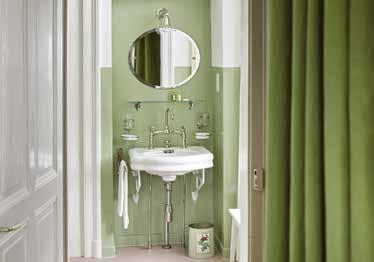

La Belle Époque fut une période faste pour la construction hôtelière en maints endroits, une tendance qui se poursuivit dans les régions touristiques suisses jusqu’à la veille de la guerre en 1914. Les établissements se multiplièrent, parfois «comme des champignons après une chaude pluie d’été». L’architecture de ces hôtels associait souvent des éléments anciens, d’époque Renaissance ou baroque par exemple, donnant lieu à un style nouveau appelé historicisme.
HOTEL BELLEVUE DES ALPES Sur la Kleine Scheidegg, le col au pied du trio Eiger, Mönch et Jungfrau, une cabane alpine abritait dès le début du XIX e siècle une auberge estivale. Le modeste établissement se retrouva bientôt entre les mains de Christian Seiler, un hôtelier de la vallée de Lauterbrunnen. Son fils Adolf y fit bâtir vers la fin du siècle le majestueux grand hôtel Bellevue.

The Belle Époque was marked by the intensive construction of hotels in many places, a process that continued in Switzerland’s tourist regions until the outbreak of the First World War. It was reported that the number of hotels increased in some places “like mushrooms after a warm rain in summer”. The architectural style of these hotels usually involved a combination of elements from earlier times – the Renaissance and the Baroque for example – which were merged into a new style, known to architectural historians as “historicism”.
HOTEL BELLEVUE DES ALPES On the Kleine Scheidegg, the pass crossing at the foot of the triumvirate of the Eiger, Mönch and Jungfrau, a summer hostelry was established in an Alpine hut in the early 19th century. This modest mountain inn soon came into the hands of Christian Seiler, a hotelier from the Lauterbrunnen Valley. His son Adolf built the imposing grand hotel Bellevue on the site towards the end of the century.

L’édifice reçut un renfort conséquent avec le Wengernalpbahn, inauguré en 1893, qui ralliait Wengen et Lauterbrunnen depuis Grindelwald via la Kleine Scheidegg. L’établissement concurrent voisin, l’hôtel Des Alpes, érigé juste après la construction du chemin de fer, fut racheté par Adolf Seiler en 1912. En 1929, il regroupa les deux maisons pour en faire l’hôtel Bellevue des Alpes et lança la première saison d’hiver. Aujourd’hui, le bon état historique des deux édifices est dû à l’entretien soigné de la structure des années durant. Les salles historiques au rez-de-chaussée et les annexes construites durant les années 1920 dans l’esprit moderne de l’époque rayonnent d’élégance. Les chambres au mobilier historique sont équipées de salles de bain d’apparence nostalgique. Héritier de la famille Seiler et propriétaire actuel, Andreas von Almen a veillé avec son épouse Silvia à préserver ce précieux héritage architectural.
This construction project was strongly supported by the Wengernalp Railway, which opened in 1893, linking Grindelwald via the Kleine Scheidegg to Wengen and Lauterbrunnen. Adolf Seiler managed to acquire the Hotel Des Alpes, which was built next door as a competitor establishment shortly after the railway was built, in 1912. In 1929 he merged the two hotels to form the Bellevue des Alpes and launched the first winter season. Today, the good state of historical preservation in both buildings can be traced back to years of careful maintenance of the structural fabric. The historic rooms on the ground floor and the additions dating back to the 1920s are sophisticated reminders of the modernist style that was all the rage at that time. The guest rooms feature period furniture and nostalgic bathrooms. As a descendant of the Seiler family, the current owner Andreas von Almen and his wife Silvia have carefully maintained this precious architectural heritage.
Arrive in historical style: by train Arriver comme jadis: en train En savoir plus More

Neues Bauen, de l’intérieur vers l’extérieur
Durant les années 1920, une nouvelle architecture radicale conquit moult pays occidentaux. Le style Neues Bauen s’imposa surtout en Autriche, dans le Tyrol du Sud et en Allemagne, trois régions limitrophes de la Suisse. Dans le souci de construire de façon économique, ces années furent dominées par un matériau nouveau, le béton armé, et l’extension de la production en série. Il était de plus capital d’intégrer les techniques de pointe comme le chauffage, l’aération et les installations sanitaires.
In the 1920s, a new, radical architectural style found its way into many Western countries. The design known as Neues Bauen was particularly popular in Austria, South Tyrol and Germany, three regions neighbouring Switzerland. Reinforced concrete became popular as a new building material at this time, and the development of mass production methods was the key to economically efficient construction. The incorporation of the latest technology – such as heating, ventilation and sanitary facilities – was also important.

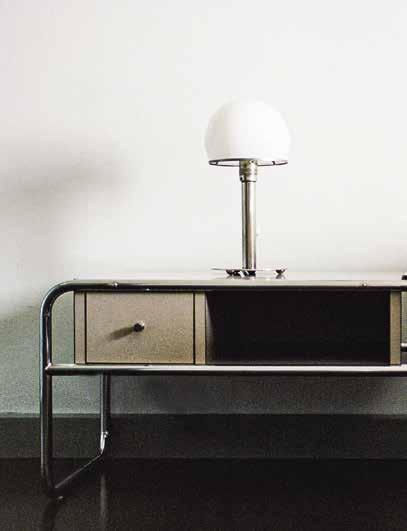
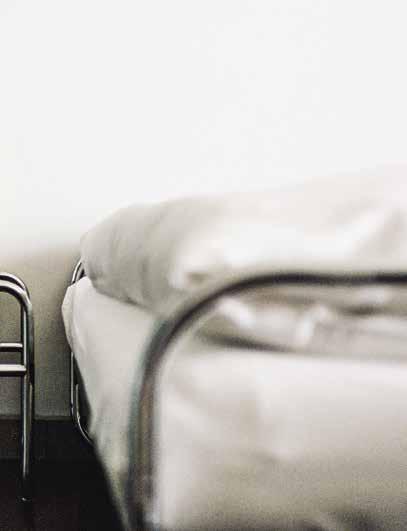
Les architectes du Neues Bauen concevaient «de l’intérieur vers l’extérieur».
À l’inverse des architectes de l’historicisme de la fin du siècle précédent, attachés à la symétrie et à la vision classique des axes, l’architecture de l’ère Neues Bauen affichait des façades d’une grande dynamique et des toitures novatrices. On recourait principalement à des lignes et des volumes clairs, des toits plats, des plans rationnels, des compositions asymétriques ainsi que de grandes ouvertures et des fenêtres à ruban dans les façades. Ornements et décorations n’avaient plus leur place. Les architectes du Neues Bauen concevaient «de l’intérieur vers l’extérieur», les façades semblaient ainsi être l’enveloppe extérieure du plan intérieur. Certains observateurs décrivirent ces bouleversements radicaux en matière de construction et d’aménagement comme un véritable changement de paradigme architectural. En Suisse, c’est surtout dans les stations de cure pour maladies pulmonaires d’Arosa et de Davos à l’est (Grisons), et à Montana et Leysin à l’ouest que furent construits ces nouveaux bâtiments, principalement des sanatoriums. Dans le même temps, quelques hôtels furent réalisés dans ce style.
HOTEL MONTE VERITÀ Cet hôtel sur le Monte Verità, la «montagne de la vérité» au-dessus d’Ascona, est l’un des rares établissements de style Neues Bauen en Suisse. Ce site construit sur la colline d’Ascona est devenu dès 1900 la résidence d’une communauté d’artistes aux visions réformatrices et aux idées anticapitalistes. Ses fondateurs, aux longs cheveux et aux vêtements réformistes, s’occupaient ensemble du jardin et des travaux agricoles et se baignaient nus pour se détendre.
In contrast to the architects of historicism in the late 19th century, who were guided by symmetry and classicism, dynamically modelled façades and sweeping roofscapes were among the characteristic architectural elements in the Neues Bauen era. Clear shapes and volumes, flat roofs, rational floor plans, asymmetrical compositions as well as large openings and strip windows in the façades were key features of the style. Ornamentation and decoration were consistently avoided. Neues Bauen architects designed their buildings “from the inside out”, so their façades appeared as the outer skin of the floor plan defined on the inside. Some analysts described these radical structural and design changes as an actual paradigm shift in architecture. New buildings were built, primarily as sanatoriums, in the eastern Swiss health resorts of Arosa and Davos (Graubünden) as well as in Montana and Leysin in Western Switzerland. At the same time, however, a number of hotels in the Neues Bauen style were also built.
HOTEL MONTE VERITÀ The hotel on Monte Verità, the “Mountain of Truth” above Ascona, is one of the few establishments that appear in the Neues Bauen style in Switzerland. The hilltop site near Ascona had already become known around 1900 as the location of a reforming, anti-capitalist artists’ colony. Together, the founders engaged in horticulture and agriculture wearing reform clothing styles with long hair and sought relaxation in nude bathing.
Neues Bauen suggests designing buildings “from the inside out”.





En 1926, apprenant l’existence de cette communauté, le banquier Eduard von der Heydt fit l’acquisition du terrain et y fit ériger un nouvel hôtel à l’aide de l’architecte de Düsseldorf Emil Fahrenkamp. L’esprit du Neues Bauen est inscrit dans l’ADN du bâtiment: un toit plat accessible, des loggias profondes en façade et de grandes fenêtres favorisant la luminosité, l’aération et l’hygiène. Sur une disposition testamentaire du banquier, le Monte Verità fut légué en 1964 au canton du Tessin qui le transféra dans une fondation spécialement créée (Fondazione Monte Verità). Un nouvel auditorium couplé à un restaurant vint s’ajouter à l’édifice selon les plans de l’architecte tessinois Livio Vacchini. Bien conservé, le bâtiment de l’hôtel de Fahrenkamp a été restauré en 2007 / 2008 avec la participation d’experts internationaux. À cette occasion, l’ensemble de l’architecture et du contenu des chambres (lits, tables, chaises et lampes) a été rafraîchi selon l’aspect d’origine.
When Dutch banker Eduard von der Heydt became aware of this colony in 1926, he immediately acquired the property and had a new hotel built by Düsseldorf architect Emil Fahrenkamp. This building has an accessible flat roof, deep loggias in front and large windows, a testament to the zeitgeist of Neues Bauen, which also focused on light, air and hygiene. In 1964, Monte Verità joined the canton of Ticino according to the will of the founder, and in 1989 it was transferred to a foundation set up specifically for this purpose (Fondazione Monte Verità). Under the guidance of Ticino architect Livio Vacchini, a new lecture hall with a restaurant was added to the existing complex. Fahrenkamp’s well-preserved hotel building was restored in 2007 / 08 with the support of international experts. The entire building and the furnishings in the guest rooms (beds, tables, chairs and lamps) were restored according to the original specifications.

Chaque Swiss Historic Hotel est un lieu de rencontre unique entre l’histoire et le présent: la chaleureuse hospitalité héritée de décennies de pratique y est offerte dans un cadre empli de caractère.
p > 30
Bâtiment principal de plus de 30 ans
Tradition hôtelière établie de longue date

Hospitality business established over a representative time span
Atmosphère historique et architecture notable
Les Swiss Historic Hotels testés par un jury d’experts remplissent les critères suivants: Main building more than 30 years old
Historic atmosphere and significance of architecture
Every Swiss Historic Hotel is a unique synthesis of past and present – a distinctive setting filled with the warm hospitality we have come to expect over many decades.
The Swiss Historic Hotels, reviewed by an expert jury, fulfil the following criteria:
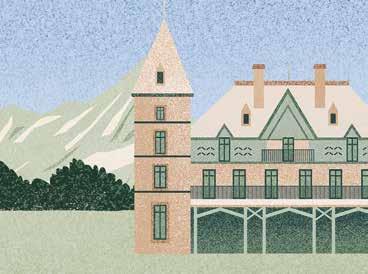
Décoration, éclairage et mobilier principalement d’inspiration historique
Rooms, lighting and furniture primarily based on the historic original
Travaux réalisés dans le respect de la conservation des bâtiments
Structural changes respect conservation requirements
Livre et bons sont disponibles en ligne.
—
Book & vouchers are available online.
Voyages culinaires dans le temps –L‘inspiration parfaite pour les passionnés de voyages
Le livre présente cinq itinéraires culinaires qui vous conduisent d’un Swiss Historic Hotel à un autre.


www.swiss-historic-hotels.ch


REGION +41 (0)32 625 10 10 info@lacouronne-solothurn.ch lacouronne-solothurn.ch
Au cœur de la vieille ville, l’imposante demeure baroque allie charme à la française, éléments historiques, artisanat traditionnel et meubles au design moderne. La Couronne est le deuxième plus ancien restaurant de Suisse.
In the heart of the old town, the spacious Baroque town house brings together French charm, historic touches, traditional craftsmanship and contemporary furniture design. La Couronne is the second-oldest inn in Switzerland. depuis since
Napoleon
La cathédrale Saint-Ours St. Ursus Cathedral

Réparties dans trois bâtiments soigneusement restaurés de la vieille ville, les 17 chambres aménagées chacune à leur façon invitent à voyager dans le temps. Planchers en bois de chêne et de sapin au léger grincement, peintures estompées et classiques du design flattent les sens.
Across three lovingly restored old town houses, the 17 individually furnished rooms invite guests on a journey through time. Gently creaking oak or pine plank flooring, muted colours and design classics enchant the senses. depuis since
Les gorges de Sainte-Vérène, la terrasse du jardin Verena Gorge, garden terrace
+41 (0)61 690 91 30 info@krafftbasel.ch krafftbasel.ch
À l’hôtel Krafft de Bâle, l’architecture historique est étonnamment conjuguée au design moderne. En 2017, il a été sacré «Hôtel urbain historique de l’année» par Historic Hotels of Europe.

In Hotel Krafft Basel, historic architecture and modern design make an inspiring combination. In 2017, it was named the “Historic City Hotel of the Year” by Historic Hotels of Europe.
Hermann Hesse, Peter Zumthor
La terrasse estivale avec ses oliviers Summer terrace with olive trees
depuis since
Cette résidence hôtelière de style Belle Époque domine le lac de Brienz. Depuis l’embarcadère, le plus vieux funiculaire d’Europe mène vers une oasis de nostalgie. Non loin du paisible hôtel grondent les chutes de Giessbach, impressionnante source d’énergie.

depuis since
This hotel residence in the typical Belle Époque style stands high above Lake Brienz. Europe’s oldest funicular railway takes you from the boat landing to an oasis of nostalgia. Not far from the tranquil hotel, the roaring Giessbach Falls is an impressive power spot.
Passeport nostalgie à Giessbach avec diverses entrées gratuites
Giessbach Nostalgia Pass offers a variety of free admissions
+41 (0)62 959 00 88 info@baeren-durrenroth.ch baeren-duerrenroth.ch
L’auberge historique regroupe trois bâtiments typiques de l’Emmental de style baroque tardif. Avec l’église de style gothique tardif et la place du village, elle fait partie des monuments historiques d’importance nationale. Les chambres confortables allient l’ancien et le moderne.
The historic country inn comprises three typical Emmental buildings from the late Baroque era. With its late-Gothic church and village square, it is an architectural monument of national importance. Its rooms are a cosy combination of old and new. depuis since
La fromagerie de démonstration de l’Emmental Emmental show dairy

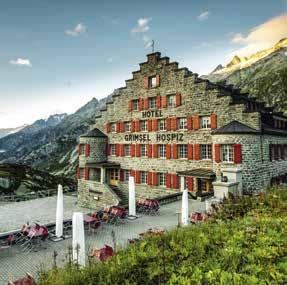
Sa reconstruction en 1932 comme premier hôtel d’Europe chauffé à l’électricité marqua l’époque. 80 ans plus tard, après une soigneuse rénovation, la demeure a rouvert avec un chauffage écologique utilisant les émissions de chaleur de centrales électriques.
depuis since
In 1932, the new hotel building caused a sensation as Europe’s first electrically heated hotel. Following comprehensive renovations, this monument has reopened its doors 80 years later – now heated using environmentally friendly waste heat from the power plants.
Le lac de barrage du Grimsel, la zone protégée de haute montagne
Grimsel reservoir, a high-alpine conservation area
KREUZ HERZOGENBUCHSEE HERZOGENBUCHSEE +41 (0)62 531 52 30
info@kreuz-herzogenbuchsee.ch kreuz-herzogenbuchsee.ch
Un esprit novateur marque l’histoire de ce bâtiment baroque, car le Kreuz a toujours été un centre social et culturel. À ce jour encore, une atmosphère chaleureuse habite cet hôtel avec bar et restaurant. Il est un point de rencontre pour jeunes et moins jeunes et un lieu de culture vivant.
The history of this Baroque building has been shaped by pioneering spirit, since the Kreuz has always been a social and cultural hub. To this day, it is a lovingly run hotel with restaurant and bar, used both as a meeting place for all ages and as a vibrant cultural centre.

Lina Bögli exhibition
depuis since
Cette maison paysanne de 12 chambres luxueusement aménagée compte parmi les plus belles réalisations de charpenterie de l’Oberland bernois du XVIIIe siècle. Dans l’auberge rénovée, les plats régionaux sont sublimés par les herbes du jardin Ricola.
depuis since
The elaborately designed farmhouse with 12 guest rooms is one of the Bernese Oberland’s most impressive masterpieces of carpentry from the 18th century. In the renovated dining rooms, regional dishes are refined using herbs from the Ricola garden.

Presque aux confins du monde, là où le réseau mobile s’arrête, la Pochtenweide dans la vallée bernoise de Kiental abrite un petit havre de paix. L’hôtel rétro de style chalet bâti en 1910 offre une alternative chaleureuse aux fastueux grands hôtels Belle Époque. Randonnée idans le Kiental
Almost at the end of the world, and away from mobile reception, an oasis of tranquillity awaits on the Pochtenweide in the Bernese Oberland’s Kiental. The nostalgic hotel was built in a chalet style in 1910 and is a homely alternative to the grandeur of the Belle Époque grand hotels.

depuis since

La liste des hôtes est aussi épatante que la vue sur l’Eiger, le Mönch et la Jungfrau. De grands alpinistes et des célébrités du monde de la culture et de la haute société ont déjà logé au Bellevue des Alpes, qui séduit par son intérieur des années 1920 parfaitement conservé.
depuis since
Eiger, Mönch & Jungfrau
The guest list is as exclusive as the view of the Eiger, Mönch and Jungfrau. Prominent mountaineers as well as celebrities from the world of culture and society have stayed at the Bellevue des Alpes, whose preserved authentic 1920s interior never fails to captivate guests.
Cet établissement construit il y a plus d’un siècle et racheté par des clients de longue date en 2014 a conservé son charme originel. La somptueuse salle de repas, la terrasse ensoleillée et l’imposante véranda offrent une vue à couper le souffle sur le massif de la Jungfrau voisin.
Bought by long-standing guests in 2014, this historic hotel is over 100 years old and has retained its original charm. The majestic dining hall, sun terrace and spacious veranda offer breathtaking views of the nearby Jungfrau massif.
depuis since

Ce château-hôtel du XIXe siècle, œuvre majeure de l’historicisme, garde en mémoire des éléments stylistiques anciens. Sur les bords du lac de Thoune, le château se dresse dans un superbe parc, sa terrasse et ses chambres offrent des vues sublimes sur l’eau et le Niesen.

depuis since
The 19th-century castle hotel is a significant example of historicism, reflecting old style elements. Right on the shores of Lake Thun, the castle lies in a splendid park, and its terrace and rooms all afford wonderful views of the water and the Mount Niesen.
Le panorama sur les montagnes autour de Thoune Mountain panorama around Thun
Famille de Pourtalès
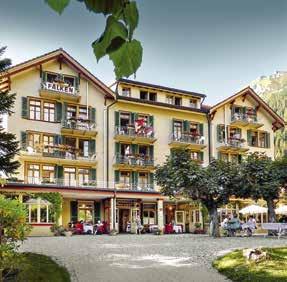
+41 (0)33 856 51 21 info@hotelfalken.com hotelfalken.com
Se restaurer dans la salle de repas datant de 1908 et parfaitement conservée, rêver dans les chambres au mobilier raffiné: l’hôtel Falken au cœur de Wengen envoûte par la subtile fantaisie de son atmosphère Belle Époque soigneusement entretenue.
Dine in a dining room with original 1908 design and sleep in stylishly furnished guest rooms: in Hotel Falken in the heart of Wengen, the carefully preserved playful ambience of the Belle Époque captivates its guests.
Les chutes d’eau de la région Waterfalls in the region
depuis since
L’architecture monastique historique réunit en son sein un hôtel cosmopolite et un prieuré bénédictin dynamique. Ce lieu unique de retraite et d’énergie offre l’espace propice au repos et à l’inspiration.
Within the historic monastery walls, a cosmopolitan hotel and active Benedictine monastery have come together. The unique place of peace and power spot provides space for recovery and fresh inspiration. depuis since

La cour intérieure du prieuré (datant de 1183)
Monastery courtyard (since 1183)

L’imposante maison de maître de plus de 400 ans offrant une vue splendide sur le sommet du Tödi compte parmi les rares maisons d’habitation suisses datant du Moyen Âge tardif encore dans leur état quasi originel. Le musée de l’habitat, le col du Klausen, l’Oberblegisee
The imposing 400-year-old manor house with a splendid view of the Tödi peak is one of a handful of dwellings in Switzerland from the late Middle Ages that are for the most part still in their original condition. depuis since
Museum of housing, Klausen Pass, Lake Oberblegi
Dans ce palais de la Renaissance et hôtel bio dominant le lac de Constance, tout invite à la détente: les 25 chambres élégantes, le spa avec bain ovale datant de 1928 et le féerique parc à l’anglaise de 1860, qui fait désormais partie du patrimoine horticole national.
depuis since
This Renaissance palace and organic hotel above Lake Constance not only boasts 25 stylish rooms and a spa with bathing oval from 1928 for the ultimate in relaxation, but also an enchanting English park from 1860, today a national garden monument.

Zita v. Bourbon-Parma
Biedermeier village of Heiden
+41 (0)81 407 22 22 info@kurhausberguen.ch kurhausberguen.ch
Sa riche architecture et son aménagement d’origine en font un trésor de l’Art nouveau. L’immense salle de banquet compte parmi les plus prestigieuses de Suisse. Aujourd’hui, l’établissement est un mariage réussi entre hôtel et appartements de vacances avec sauna et bain à remous.
La ligne de chemin de fer inscrite au Patrimoine mondial de l’UNESCO
A true art nouveau gem with spacious architecture and original interiors. The impressive ballroom is one of the most prized in Switzerland. Today the resort comprises a successful mixture of hotel and holiday apartments with sauna and whirlpool.
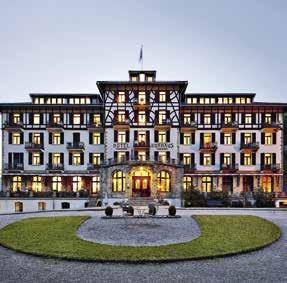
UNESCO World Heritage railway line
depuis since

Jadis une maison paysanne, aujourd’hui une somptueuse demeure: au cœur du spectaculaire paysage de montagne de l’Engadine, la Chesa Salis transforme avec charme ses 450 ans d’histoire en grandeur aristocratique et convivialité rustique.
Once a farmhouse, today a magnificent palazzo: the Chesa Salis blends 450 years of history with rustic cosiness and aristocratic grandeur, all in the heart of the spectacular mountain landscape of the Engadin.
depuis since
Le Val Bever, le jardin de l’hôtel aux allures de parc
Val Bever, the park-like hotel garden
stern-chur.ch
Depuis 1677, l’hôtel familial Stern, au centre de Coire, est l’adresse privilégiée des gourmets: la renommée de ses spécialités régionales et des vins exceptionnels grisons dépasse l’enceinte de la ville.
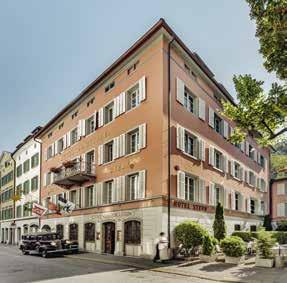
The familial Hotel Stern in the heart of Chur has been a favourite of connoisseurs since 1677: today, the regional delicacies and fine wines from Graubünden are wellknown even outside of the city.
depuis since
Construit en 1900, le bâtiment abritait à l’origine un sanatorium en raison de son altitude. S’il a été transformé en hôtel dans les années 1950, l’air pur est resté. L’hôtel est aujourd’hui une vraie oasis alpine dont le jardin accueille plus de 5500 plantes différentes.
depuis since
Because of the good mountain air, the building was conceived as a sanatorium around the year 1900. It was converted into a hotel in the 1950s, though the air remains as fresh as ever. Today, the hotel is an Alpine oasis. The hotel garden is home to more than 5,500 plant species.
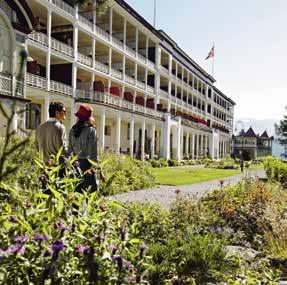
Cet hôtel de montagne est un voyageur extraordinaire. Entre passé et présent, station thermale mondaine et calme alpin. Il se trouvait autrefois à St-Moritz, puis à la fin du XIXe siècle, il fut entièrement démonté et reconstruit dans la vallée reculée de Fex. Le calme, la nature, les montagnes
This mountain hotel is quite the world traveller. Between past and present, a chic spa resort and oasis of Alpine tranquillity. It could once be found in St. Moritz, but was dismantled in the 19th century and rebuilt in the remote Fex Valley. depuis since

Cette maison patricienne historique se situe au cœur du village de montagne de Fideris. Sa tour fièrement dressée aurait bien des histoires à raconter sur les quatre derniers siècles. La chambre «Himmel» reflète parfaitement l’atmosphère historique de la maison.
depuis since
The historic patrician residence lies in the heart of the mountain village of Fideris. With its distinctive tower, it surely has many tales to tell from the last four centuries. A stay in the “Himmel” (heaven) room really makes you feel as if you’re close to history.

Le village de montagne de Fideris
Mountain village of Fideris
+41 (0)81 928 10 10 info@schweizerhof-flims.ch schweizerhof-flims.ch
Depuis 1903, cet établissement est connu mondialement pour sa qualité d’excellent hôtel et de lieu culturel. Des figures telles qu’Albert Einstein et Marie Curie y ont passé l’été et goûté à la magie de la Belle Époque, entretenue jusqu’à aujourd’hui.
Albert Einstein, Marie Curie
Since 1903, it has been known as not only an exceptional hotel but also a cultural centre. Icons such as Albert Einstein and Marie Curie spent their summers here and enjoyed the magic of the Belle Époque, which continues to sparkle to this day. depuis since

L’hôtel recèle sa passionnante histoire dans une maison du XVIIe siècle ornée de sgraffite et typique de l’Engadine. Il est tenu depuis 1893 par la famille Meisser. Les hôtes dégustent des plats régionaux dans la salle de repas datant de 1902 et classée monument historique.

depuis since
Schellenursli-Museum, Piz Buin (3312 m)
Adorned with sgraffito, the Engadin hotel dating back to the 17th century is testament to a rich history. It has been run by the Meisser family since 1893. Guests can savour regional dishes in the listed dining room dating back to 1902.

+41 (0)81 422 22 22 hotel@chesagrischuna.ch chesagrischuna.ch
Conçu telle une œuvre d’art globale, l’hôtel est rapidement devenu un espace de liberté mythique pour les artistes et intellectuels. La cuisine est tout aussi surprenante que le savant mélange d’architecture traditionnelle et d’art contemporain.
Planned as a complete work of art, the small hotel soon became a legendary space for artists and intellectuals. Just as creative as meshing tradition and contemporaneity is the fine cuisine of the house. depuis since
L’église Saint-Jacques St. Jakob Church

Cet hôtel historique fait penser à un coffre au trésor rempli d’histoires et d’histoire. La salle des sibylles, avec ses portraits de femmes mythologiques, impressionne particulièrement. L’édifice fut construit en 1682 pour être la résidence officielle du maire.
depuis since
La salle des sibylles Room of the Sibyls
The hotel is a treasure trove of stories and history. The Room of the Sibyls is particularly impressive, with its 12 oil paintings of mythological women. The palazzo was built in 1682 as the mayor’s representative residence.
L’ancienne cour du fief fut un hospice et un poste de douane jusqu’en 1944. L’auberge abrite des chambres d’origine, situées pour partie dans le chalet construit en 1913 par le musicien Willem Mengelberg. Zuort associe l’ambiance d’une ferme du Tyrol à l’esprit Belle Époque.
The old farmstead was a hospice and up until 1944 a customs post. The inn includes rooms true to the original style, with some of these in the chalet built by musician Willem Mengelberg in 1913. It combines the ambience of a Tyrolean highland farm with the spirit of the Belle Époque.
depuis since

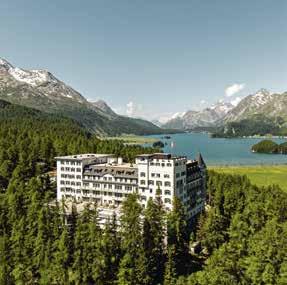
L’hôtel est tenu par la même famille depuis cinq générations. Le bâtiment est emblématique du succès de la tradition hôtelière suisse: derrière la façade chargée d’histoire, les hôtes apprécient le style personnel qui régit l’établissement depuis plus de 110 ans.
depuis since
Le lac de Sils Lake Sils
Guests today are welcomed here by the fifth generation of the same family. The hotel is a prime example of successful Swiss hotel tradition: behind the historic façade, guests can enjoy the personal way in which the hotel has been run for more than 110 years.

Ce palazzo transformé en auberge il y a 100 ans offre une ambiance unique et séduit avec ses 16 chambres, ses salles splendides et son jardin planté de séquoias, ces arbres si rares. Giovanni Segantini et Alberto Giacometti ont séjourné ici.
The palazzo, which was turned into a guest house 100 years ago, has a unique ambiance. It enchants visitors with its 16 rooms, splendid large halls and garden with rare redwood trees. Giovanni Segantini and Alberto Giacometti have both stayed here.
Les chutes d’eau, le restaurant, les montagnes Waterfall, restaurant, mountains
depuis since
+41 (0)81 630 91 30 info@weiss-kreuz.ch weiss-kreuz.ch
La réception de l’auberge était jadis l’entrée des bêtes de somme du gîte construit en 1519 pour les muletiers de l’axe alpin Munich-Milan. Le restaurant est dans l’ancienne grange à foin et les marches grinçantes de l’escalier mènent aux 16 chambres douillettes.

depuis since
What is now the main entrance was once the entrance for pack animals in this hotel built in 1519 for muleteers on the transalpine crossing between Munich and Milan. The restaurant is in the converted hay barn, and creaking wooden stairs lead to the 16 cosy rooms.
Le cœur du village de Splügen Village centre of Splügen
Au cœur d’un paysage époustouflant, cet hôtel de 1896 qui appartient toujours à la famille Badrutt fait non seulement figure d’emblème de St-Moritz, mais aussi de légende des hôtels suisses par excellence.
Surrounded by a breathtaking landscape, the hotel, which opened in 1896 and is still owned by the Badrutt family today, is not only a landmark of St. Moritz, but also a Swiss hotel legend.
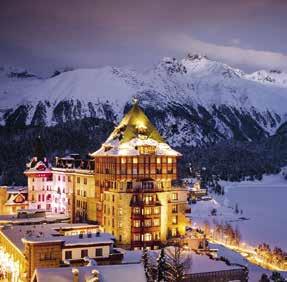
La vue sur le lac de St-Moritz
Views of Lake St. Moritz
depuis since

Ici passaient des chevaliers, troubadours, nobles et muletiers: la maison est remplie de trésors historiques. Même Albert Hofmann, découvreur du LSD, succomba à sa magie. Il écrivit dans le livre d’or: «La magie est ici au rendez-vous, même sans champignons hallucinogènes.»
depuis since
Over years, it has welcomed knights, minstrels, nobility and muleteers. A building filled with historic treasures. Albert Hofmann, the man who discovered LSD, was captivated by its charm. He wrote in the guest book: “Here, you can experience something magic, without the mushrooms.”
Partir en vacances sans stress et dans le respect du climat avec les transports publics.
Vos bagages sont pris en charge chez vous et vous attendent à votre hôtel. cff.ch/shop-bagages




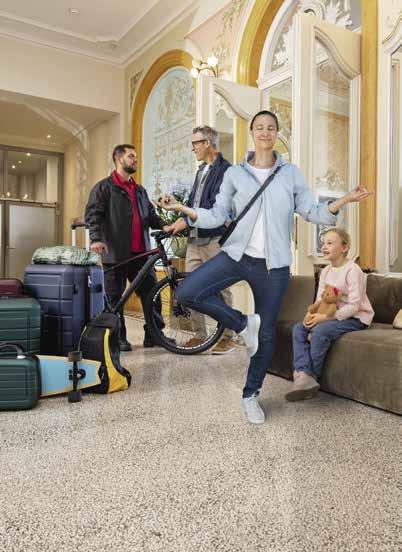
La façade de l’hôtel offre un premier aperçu de l’impressionnante histoire du lieu. Ouvert aux alentours de 1500, le Crusch Alva est l’un des plus vieux établissements de Suisse. Il faisait à l’époque office d’auberge juridique et la justice était rendue en ses murs.
depuis since
The façade of the hotel hints at its impressive history. The Hotel Crusch Alva opened in 1500 and is one of the oldest inns in Switzerland. Back then, it was used as a legal building, and was a place where judicial verdicts were passed.
Albert Einstein Restaurant Stüva


Depuis 125 ans, à 1200 mètres d’altitude, situé sur l’Arc jurassien vaudois, le palais Belle Époque offre un panorama unique sur les Alpes, avec une vue portant du Mont-Blanc à la Jungfrau. Le restaurant datant de 1913 est empreint de détails architecturaux.
The 125-year-old Belle Époque Palace glows in its classic beauty and is a box seat to the Alpine chain from Mont Blanc to the Jungfraujoch. The Belle Époque restaurant has been welcoming guests since 1913 and is reminiscent of the days of festive balls.
Chasseron (1600 m), Sport été et hiver
depuis since
Ce sobre hôtel installé dans un ancien monastère clunisien est un havre de calme qui n’est accessible qu’à pied, à vélo ou par bateau. Les 14 chambres réaménagées avec style et soin offrent un fabuleux contraste avec les vieux murs du monastère.
depuis since
L’île St-Pierre St. Peter’s IslandThe sobre hotel within the walls of a former Cluniac monastery is an oasis of tranquillity and can only be reached on foot, by bicycle or by boat. The 14 rooms have been carefully and stylishly redesigned, creating an exciting contrast against the old monastery walls.
 J. W. Goethe, Joséphine Bonaparte
J. W. Goethe, Joséphine Bonaparte
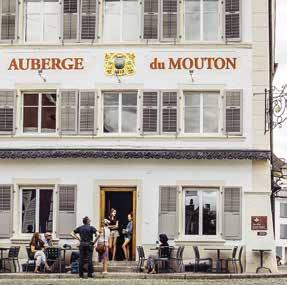
Cette auberge située dans la vieille ville historique de Porrentruy a été soigneusement rénovée en 2016. Son restaurant est dédié à la cuisine du terroir. En été, il est possible de manger en terrasse et d’observer l’animation de la rue.
The inn in the historic city centre of Porrentruy was renovated in 2016 with careful attention to detail. The hotel’s own restaurant fully ascribes to the philosophy of “terroir”, or regional-based cooking; in summer, guests can dine on the terrace and watch the goings-on in the streets.
La cuisine du terroir Terroir cuisine
depuis since
Déjà attestée en 1357, cette auberge romantique compte parmi les plus anciennes de Suisse centrale. Le bâtiment actuel datant de 1788 rappelle en de nombreux détails la grande époque des mallesposte franchissant le Saint-Gothard.
depuis since
First mentioned in historic documents dating back to 1357, this romantic guest house is one of the oldest in Central Switzerland. Rebuilt in 1788, many of the current building’s features hark back to the golden age of the stage coach on the Gotthard.


+41 (0)41 488 11 66 willkommen@kurhaus-fluehli.ch kurhaus-fluehli.ch
Une transformation soignée et une réfection complète ont permis à cette maison de cure au sein de la UNESCO Biosphère Entlebuch de faire peau neuve. Elle associe des éléments historiques soigneusement entretenus au confort moderne et à une hospitalité d’exception.
In the UNESCO Biosphere Entlebuch, the 100-year-old health resort now shines in new splendour after a slight conversion and comprehensive renovation. It offers the perfect combination of carefully preserved historic elements with modern comfort and unique hospitality. depuis since
Ce joyau, un monument protégé, se trouve dans un lieu d’énergie près du centre géographique de la Suisse. Divers salons confortables ainsi que la salle de repas historique et sa véranda longue de 47 mètres invitent à se détendre et profiter.
This jewel is located at an energy point not far from the geographic centre of Switzerland. The hotel is a listed building; various cosy lounges and the historic dining room with its 47-metre veranda are perfect places to relax and unwind.
depuis since

wilden-mann.ch
Au fil de ses 500 ans de service auprès de ses hôtes, le Wilden Mann de Lucerne, charmant hôtel situé au cœur de la ville, a investi, soigneusement aménagé et restauré sept bâtiments imbriqués typiques du vieux centre.
Guests have been welcomed at the Wilden Mann in Lucerne for the past 500 years. During this time, the charming hotel in the heart of the city has grown to fill seven interconnected old town houses, which have been lovingly designed and furnished.
depuis since

Dans les anciens murs de l’abbaye, l’atmosphère du lieu et l’esthétisme des 14 élégantes chambres sont loin d’être les seuls atouts. L’héritage culinaire alpin est un ravissement, tant dans le spacieux restaurant et la boutique du monastère que dans la cuisine dédiée aux cours.
depuis since
Housed within the old, atmospheric monastery walls, the 14 stylish hotel rooms are a treat in themselves. The culinary heritage of the Alps can be savoured in the spacious restaurant, monastery shop and cookery school kitchen.

Se promener dans le paysage «comestible» et savourer 250 variétés de plantes
Walking in the “edible” landscape and snacking from 250 plant varieties
L’hôtel et son restaurant avec jardin ne pouvaient être situés en un plus beau lieu: les pieds presque dans l’eau, il contemple les douces vagues du lac des QuatreCantons. L’embarcadère et les trains du Rigi sont aussi tout proches.
The hotel, along with its garden restaurant, could not be in a more beautiful location: sitting right on the water, it invites guests to look out across the soft waves of Lake Lucerne. Also nearby, there are boats docking and trains that go up to the Rigi.

depuis since
L’escapade à Lucerne, la randonnée sur le Rigi, le tour en vélo électrique
City trip to Lucerne, Rigi hike, e-bike tour
+41 (0)91 785 40 40 info@monteverita.org monteverita.org
Le Monte Verità est de longue date un lieu ouvert aux idées et aux arts. À côté de cette auberge de style Neues Bauen à l’élégance sobre, les hôtes trouvent l’inspiration au restaurant panoramique, dans les musées, la maison de thé et le jardin zen japonais ainsi qu’au parc.
depuis since
La maison de thé, le parc Tea house, garden, park
Monte Verità was and is a place of ideas and the arts. Guests can find inspiration in the sleek elegance of the Albergo built in the Bauhaus style and in the panoramic restaurant, museums, Japanese tea house and Zen garden, as well as the park.

+41 (0)91 608 32 65 info@posta-astano.ch posta-astano.ch
Cet ancien bâtiment de la poste niché au fond du Malcantone, région sauvage et romantique, est déjà attesté en 1888 comme «albergo». Jusqu’à ce jour, l’hôtel a conservé son caractère typique de maison tessinoise.
Deep in the wildly romantic Malcantone region, this former post office building has been a hotel since 1888. To this day, the hotel has retained the character of the typical Ticino house.

Monte Lema, Miniera d’oro di Sessa
depuis since
Cette romantique maison patricienne vieille de 200 ans est une oasis de bienêtre au charme méditerranéen. La maison familiale séduit par ses 18 chambres personnalisées et son fabuleux jardin avec piscine.
depuis since
The romantic, 200-year-old patrician residence is an oasis of well-being with Mediterranean charm. The familial-run hotel has 18 rooms with individual designs and an enchanting garden with pool.
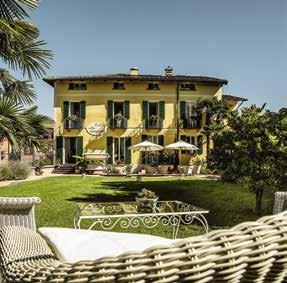
+41 (0)91 780 60 09 info@palazzogamboni.ch palazzogamboni.ch
Cette maison patricienne lombarde bâtie vers 1700 par Remigio Gamboni a été restaurée selon l’original et dotée de cinq superbes chambres en 2001. L’artiste phare du mouvement dada Max Ernst et l’écrivain Elias Canetti venaient déjà s’y inspirer.
Max Ernst, Elias Canetti
Remigio Gamboni built this Lombard patrician residence around 1700, and it was restored to its original style in 2001 with five charming rooms. Dada artists Max Ernst and Elias Canetti found inspiration within these walls. depuis since
L’architecture à Comologno Architecture in Comologno
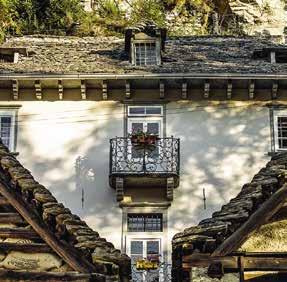
Au cœur d’un paysage authentique et entourée d’arbres anciens, la villa réunit les époques passées dans neuf chambres aménagées avec goût. Aux joies de l’art, des concerts ou de la cuisine régionale succède un silence reposant.
Surrounded by an authentic landscape and ancient trees, the villa combines past decades in nine tastefully furnished rooms. The enjoyment of art, concerts or regional cuisine is followed by restful silence. depuis since Église de Mario Botta à Mogno Church by Mario Botta in Mogno
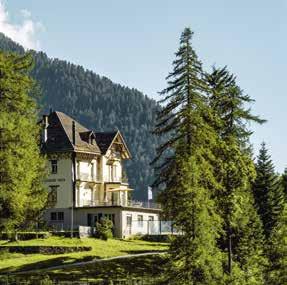
Ce palais historique de style Belle Époque est un lieu charmant au luxe discret. Une attention particulière est accordée à la gastronomie, avec une variété de propositions allant de la cuisine raffinée aux plats méditerranéens et aux cocktails de marque.
The historic Belle Époque-style palace is a charming place of discreet luxury. Special attention is focused on gastronomy, with various proposals from fine dining to Mediterranean dishes and signature cocktails. depuis since

Cet imposant hôtel de montagne de 1896 transporte ses hôtes à l’âge d’or de l’alpinisme. L’établissement familial à la façade en pierre et en bois, situé au cœur de la forêt d’arolles et des majestueuses montagnes, invite à éveiller l’esprit d’aventure en chacun.
depuis since
Staying at this noble mountain hotel from 1896 is like a journey through time to the heyday of Alpine mountaineering. The family-run hotel with its stone and timber façade lies in the heart of a stone pine forest amidst the impressive mountains, awakening a new thirst for adventure.
La terrasse panoramique, J. Baker Bar Panoramic terrace, J. Baker Bar


Les salles et chambres soigneusement rénovées de cet hôtel traditionnel du XIXe siècle offrent un voyage dans le temps, du Biedermeier à l’après-guerre en passant par la Belle Époque. Un joyau unique dans la «vallée des trésors cachés».
The 19th-century hotel steeped in tradition invites guests on a journey through time with lovingly restored lounges and rooms from the Biedermeier period and the Belle Époque to the post-war era. In the “valley of hidden treasures”, it is undoubtedly a special gem.
Le Parc naturel de la Vallée de Binn Binntal Nature Park
depuis since
Dans cette ancienne demeure seigneuriale située au pied des cols de haute montagne du Nufenen, du Grimsel et de la Furka, l’hospitalité se cultive de longue date. Goethe aussi y a séjourné. Le restaurant sert aujourd’hui des spécialités régionales sur des plateaux en argent.
depuis since
In the former regal residence at the foot of the Nufenen, Grimsel and Furka high-mountain passes, hospitality has been writ large for centuries. Even Goethe was known to stay here. Today, the restaurant serves regional specialities on silver trays.

La piste de ski de fond (100 km) Cross-country ski trail (100 km)
J. W. Goethe
Edward Whymper a séjourné dans cet hôtel historique de 41 chambres et suites lorsqu’il a été le premier à gravir le Cervin en 1865. La demeure dégage toujours le charme de la Belle Époque alpine, mais avec toutes les commodités d’aujourd’hui.
Edward Whymper stayed in the historic hotel with 41 rooms and suites when he was the first to climb the Matterhorn in 1865. The building still embodies the charm of the alpine Belle Époque, but with all of today’s modern conveniences.
depuis since
Au travers de ses chambres aménagées comme à l’origine et de ses meubles historiques, ce grand hôtel bâti sur les fondations d’une villa romaine ramène à la fin du XIXe siècle et offre le parfait mélange entre histoire culturelle et tradition hôtelière de prestige.
depuis since
The rooms of this grand hotel built on the foundations of a Roman villa are decorated in their original style with historic furniture from the 19th century – striking a perfect balance between cultural history and grand hotel tradition.
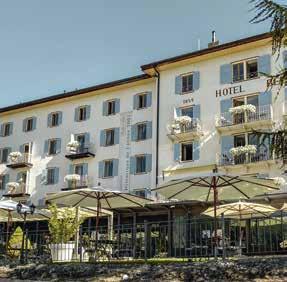

À l’origine, le Masson était une maison vigneronne entourée de vignes. Aujourd’hui encore, cet hôtel qui compte parmi les plus anciens et charmants de Montreux, offre une vue imprenable sur le lac Léman et exhale un charme méditerranéen.
The Masson was built as a vintner’s home and was originally surrounded by vineyards. As one of the oldest in Montreux, this charming hotel still offers breathtaking views of Lake Geneva today and exudes Mediterranean charm. depuis since


+41 (0)24 492 22 09 pillon@hoteldupillon.ch hoteldupillon.ch
Cette grande maison d’hôtes de 14 chambres est située à un jet de pierre de Glacier 3000, entourée des Alpes vaudoises. Meubles anciens et peintures aux accents historiques et culturels donnent un charme raffiné à cet établissement aménagé par un marchand d’art parisien.
Glacier 3000, la terrasse avec vue
The great 14-room guest house is situated in the heart of the Vaud Alps, not far from Glacier 3000. It was decorated by a Parisian art dealer – antique furniture and paintings on cultural history lend it a refined charm.
Glacier 3000, terrace with a view
depuis since
La façade baroque recèle un élégant bâtiment de 1873 doté d’une cour baignée de lumière et d’un espace spa petit mais raffiné, avec des bains du XIXe siècle restés fidèles à l’époque.
Behind the Baroque façade lies an elegant building dating from 1873 with a lightfilled courtyard and the small but splendid spa area with baths true to the original style from the 19th century.

depuis since
Villa Langmatt,
+41 (0)43 411 11 22 gasthof@hirschen-eglisau.ch hirschen-eglisau.ch
Outre une situation d’exception avec vue directe sur le Rhin, cette auberge soigneusement rénovée dispose de sept chambres et suites de style XVIIe à XIXe siècles. Un véritable équilibre parfaitement réussi entre tradition et modernité.
In addition to its beautiful location with direct views of the Rhine, this carefully restored guest house offers seven rooms and suites in the styles of the 17th to 19th centuries. The balance between tradition and modernity has been perfectly struck here.
 J. W. Goethe
J. W. Goethe
La croisière sur le Rhin Cruising on the Rhine
depuis since
Une émeraude sous le soleil du lac de Zurich: situation idyllique, symbiose entre patrimoine historique et architecture contemporaine. Avec ses 40 chambres raffinées, le Sonne rayonne d’une beauté intemporelle.
An emerald on the sunny side of Lake Zurich: with its 40 stylish rooms and splendid location, the Sonne perfectly combines a historic building with contemporary architecture, radiating timeless beauty. depuis since
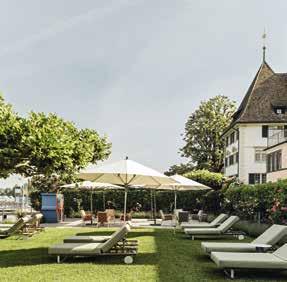
Les 80 tableaux de l’établissement 80 paintings in the hotel
C. G. Jung, Franz Kafka
Le Hirschen est l’une des maisons bourgeoises du XVIIe siècle les plus importantes du paysage zurichois. Sa cuisine primée, le vin local et ses chambres chargées d’histoire rendent cet établissement réellement unique dans la région.
The Hirschen is one of the finest examples of a 17th-century town house in the landscape of Zurich. The award-winning kitchen, local wines and mostly historic rooms are what make this place so unique in the region. depuis since

La chapelle Saint-Gall, le paysage lacustre, le site de Stammheim
Gallus chapel, lake landscape, village of Stammheim
Le Gyrenbad est un bijou: cette emblématique auberge au cœur d’un paysage pittoresque compte parmi les plus traditionnelles et les plus belles de Suisse. En 1997, elle fut la première à obtenir la distinction «Hôtel historique de l’année». Les hôtes emplissent le lieu de chaleur et de culture.

depuis since
The jewel of Gyrenbad: this iconic country inn is situated in an idyllic environment and is one of the most original and beautiful in Switzerland. In 1997, it was the first hotel to be named “Historic Hotel of the Year”. The hosts fill the hotel with both culture and heart.
Le jardin de cure historique Historical spa garden
+41 (0)44 266 10 10 info@marktgassehotel.ch marktgassehotel.ch
La Marktgasse est l’une des plus vieilles auberges de Zurich et resplendit toujours d’un éclat intemporel. Associée à un design élégant et à la haute gastronomie d’Andreas Caminada, la maison est un lieu culte de la vieille ville zurichoise. La Limmat, la vieille ville, le lac de Zurich

The Marktgasse is one of the oldest guest houses in Zurich and still boasts a timeless charm. Combined with tasteful design and top gastronomy by Andreas Caminada, the guest house has cult status in Zurich’s old town. depuis since
Limmat, old town, Lake Zurich
Companies marked with the Swisstainable insignia are committed to the responsible use of resources in Switzerland as a travel destination.
MySwitzerland.com/swisstainable
hotelleriesuisse.ch raiffeisen.ch swiss.com sbb.ch
mystsnet.com
americanexpress.ch coop.ch europcar.ch victorinox.com
gastrosuisse.ch cheesesfromswitzerland.com
swisstravelcenter.ch gubelin.com bmc-switzerland.com appenzellerbier.ch hertz.ch harley-davidson.com
mammut.com landquartfashion outlet.com
kambly.com swica.ch
kirchhofer.com
zuerich-airport.com zurich.ch rausch.ch whes.ch
swissinfo.ch
swisseducation.com swissrent.com swiss-ski-school.ch visana.ch swisswine.ch
Recommended by Switzerland Tourism. MySwitzerland.com
Publisher Switzerland Tourism MySwitzerland.com
Production, Concept & Text Transhelvetica, Passaport AG Pia & Jon Bollmann Laura Meier | Max Wild Design Anna Sarcletti transhelvetica.ch passaport.ch
Switzerland Tourism Anouk Blum | Annika Grünig | Sarah Krauer | Susanne Berther
Illustration Mira Gisler, miragisler.ch
Text (Zeitreise) Roland Flückinger
Proofreading Carola Bächi & Flexipool carolabaechi.ch
Photography Juliette Chretien juliettechretien.ch
Cover Photography (Schloss Schadau, Thun) Jonathan Ducrest jonathanducrest.com
All other photos provided by Switzerland Tourism and its partners.
Copyright Switzerland Tourism, all rights reserved.
Edition January 2023 Print run 45 000 Languages de | fr | it | en Printer Multicolor Print AG multicolorprint.ch
There are two hotel classification systems in Switzerland. You will find information on both systems at: hotelleriesuisse.ch gastrosuisse.ch







